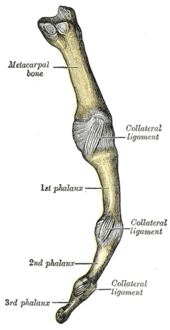Phalanx (anatomy)
In anatomy and medicine, the phalanx is a bony finger or toe . The majority are phalanges . The term is derived from Latin (phalanx) and Greek (phálagx), which means something like "tree trunk" or "row".
Anatomically, a finger or a toe is made up of the base phalanx (proximal phalanx), the middle phalanx (middle phalanx) and the end phalanx (distal phalanx). The ends have articular surfaces covered with cartilage . The thumb and big toe are the exception here and are only two-part.
The listing of the number of phalanges on the fingers or toes of a limb is called the phalangeal formula . For the human hand - with a two-part thumb and four three-part fingers - it reads: 2-3-3-3-3, as is the case with the human foot. In other terrestrial vertebrates such as B. Monitor lizards , the phalangeal formulas of fore and hind limbs can differ.
